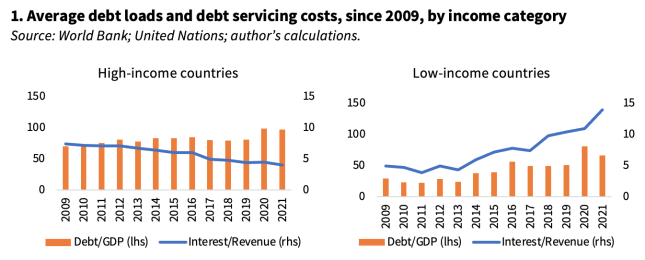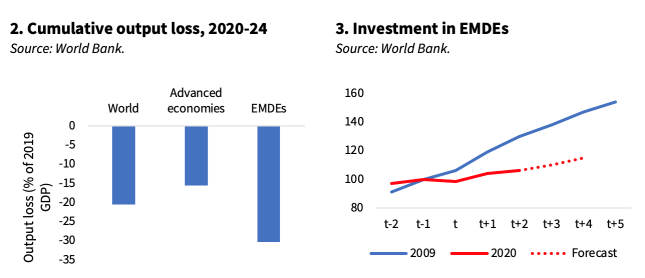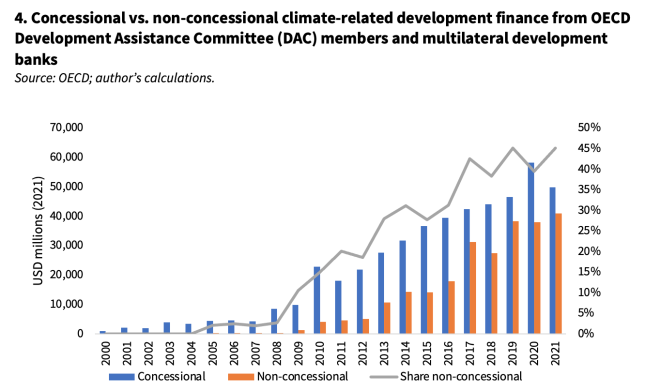-
Want to Beat Global Warming? Beat Global Indebtedness First
July 25, 2023 By Anuj Krishnamurthy
The world has a sobering debt problem. In the wake of the COVID-19 pandemic, Russia’s invasion of Ukraine, and the ensuing shocks to commodity prices, governments everywhere have borrowed enormous sums to promote stability and kickstart recovery.
But this problem is most acute for low and lower middle-income (“lower-income”) countries, whose debt burdens have reached unsustainable levels. Twenty percent of the world’s population lives in countries in or on the brink of “debt distress,” meaning they are likely to default on their obligations.
Kristalina Georgiva, head of the IMF, said in an April speech that wealthier nations must urgently “help [low-income countries] handle the burden of debt, which was made so much harder by the shocks of the past years.” And this past June, France hosted the Summit on a New Global Financing Pact, where world leaders—including Treasury Secretary Janet Yellen—convened to discuss reforms to the global financial system and key risks to sustainable development, such as growing debt burdens.
The problem of global debt, left unresolved, will make it harder for the international community to overcome what is perhaps the world’s most pressing challenge: climate change. As debt levels mount, so too do the required interest payments, leaving heavily indebted governments with fewer resources to invest in areas like health and education, let alone a transformation of their existing energy systems.
All countries must reduce emissions and transition their economies away from fossil fuels, but avoiding catastrophic climate change hinges particularly on lower-income countries and their ability to access sufficient financing to decarbonize. After all, lower-income countries remain heavily dependent on fossil fuels and have the greatest development needs.
Yet without dramatic changes in these countries’ emissions trajectories, the international community will exceed its carbon budget and experience dramatic warming—the worst effects of which will befall the world’s poorest and most vulnerable. But right now, lower-income countries do not have the fiscal capacity to act.
The Challenge of Debt and Decarbonization in Lower-Income Countries
To achieve meaningful emissions reductions globally, lower-income countries must have the resources to undertake extensive decarbonization. If the emissions trends of the past ten years persist, global annual Kyoto GHG emissions in 2050 may be nearly 20 percent higher than in 2021. And the emissions attributable to lower-income countries? They could grow by 66 percent. Only high-income countries will see a fall in emissions over that timeframe. This scenario is plainly incompatible with efforts to reduce emissions over time and limit global warming to 1.5 degrees Celsius.
Decarbonizing lower-income countries will be expensive, however. In emerging markets, annual average investment to achieve net zero by 2050 would need to reach $2 trillion between 2026 and 2030—and almost $3 trillion between 2031 and 2040—particularly in the electricity, transport, and buildings sectors. Has the international community successfully mobilized enough financial firepower to facilitate this investment? And do lower-income countries themselves have the capacity to invest and transform their economies?
On both counts, the answer is “no.” The international community’s track record in supplying climate finance does not inspire confidence. Even before the COVID-19 pandemic, wealthy nations failed to meet the goal established at COP15 in Copenhagen of mobilizing $100 billion for poorer countries. In 2020, the latest year for which data is available, international climate finance reached just $83.3 billion. Notably, nearly three-quarters of the public climate finance provided between 2016 and 2020 took the form of loans that must be paid back, not grants.

Lower-income countries also lack the fiscal flexibility to fund decarbonization efforts on their own, owing to their large debt loads. Yes, the world as a whole is heavily indebted: according to IMF figures, the world’s debt-to-GDP ratio reached 247 percent in 2020, the highest level since 1970. But lower-income countries pay much more in interest than their higher-income counterparts—a discrepancy that some have termed the “great finance divide”—which puts a major strain on their limited resources and diverts government spending away from investment and public services. Since 2009, the average low-income country has seen its debt servicing costs rise rapidly, reaching nearly 14 percent of government revenue in 2021 (Figure 1). In comparison, the average high-income country can shoulder a much larger debt load and pay just 4 percent in debt servicing costs.
Kenyan President William Ruto has argued that, under these conditions, lower-income countries should not be expected to assume more debt, at high interest rates, to decarbonize—and even called for the creation of entirely new institutions to lay the groundwork for a financial system that does not privilege advanced economies.

If a period of sustained recovery and economic growth were imminent, elevated debt levels and interest payments resulting from recent economic shocks could be more easily managed. But over the 2020-2024 timeframe, lower-income countries are projected to experience cumulative output losses far greater than the world as a whole, and their recoveries have so far been anemic (Figure 2).
For example, investment levels in lower-income countries are rebounding at a much slower pace after COVID-19 than the global financial crisis (Figure 3). Sluggish investment in lower-income countries is particularly worrisome in light of those countries’ “large unmet investment needs” in areas like healthcare, public infrastructure, and education. Not only do lower-income countries lack the ability to borrow the large sums necessary to drive their energy transitions, but even their pre-pandemic investment levels have yet to recover.
Clarifying Climate Finance
The problem of indebtedness in lower-income countries is alarming, especially given the urgency of the climate crisis and the acute need for investment in decarbonization. Policymakers globally must articulate a more precise taxonomy of climate-related development finance that encourages more concessional and grant-based funding (versus loans) from advanced economies to lower-income countries. In turn, the international community should center subsidy reform in future climate negotiations, supporting lower-income countries in their transition away from fossil fuel subsidies.
Beyond high-income countries’ limited willingness to pay, one of the biggest obstacles to ramping up climate finance is a lack of consensus about what kinds of financial assistance should count. As one World Bank senior managing director observes, “right now… we don’t have a solid handle on the basic numbers.” For example, some countries treat financing for efficient coal plants as climate finance, even though coal is not a zero-carbon energy source. Between 2000 and 2021, donor countries and multilateral banks contributed $3.5 billion in coal-related climate finance, the bulk of which went to least developed countries.

Further, a growing portion of climate-related development finance thus far has taken the form of non-concessional financing, which only exacerbates the debt burden of lower-income countries. (The Chair’s summary for the recent Summit on a New Global Financing Pact underscores the importance of “concessional, low-cost finance… to tackle global challenges.”) According to OECD figures, the share of climate-related development finance classified as “not concessional or not primarily developmental” from major donor countries and multilateral development banks has grown from 28 percent in 2015 to 45 percent in 2021, even as human activities result in soaring temperatures and lower-income countries’ financial positions deteriorate (Figure 4).
While high-income countries cannot be compelled to provide financing, a stricter reporting regime might better enable accountability and reduce additional debt incurred by lower-income countries. Such a regime would give donor countries and institutions more credit for concessional forms of financing and investments in zero-carbon projects, and would impose some sort of third-party review of donor countries’ self-reported climate finance.
One place to start is the system of markers used by donor countries to identify development finance flows targeting the focus areas of the Rio Conventions, which include climate change adaptation and mitigation. The Rio markers are not perfect measures by any means, but they could be a foundation to build one.
For instance, the Rio system is ill-suited at present to track climate finance adequately. The Rio marker handbook even acknowledges that the system was not created to “quantify finance flows.” It also fails to take into account lower-income countries’ fiscal conditions. While the markers include a scoring system that tracks the degree to which the reported development activities advance the Conventions’ objectives, the Rio marker handbook makes no reference to concessionality or the fiscal effects of the reported activities on recipient countries. What good is a project that has emissions reductions as its “principal” motivation (the highest Rio score), for example, if it adds to a low-income recipient country’s debt load and debt servicing costs?
Rather than using a one-dimensional scale of relevance to specific environmental objectives, the Rio scoring methodology should include a second dimension for financing concessionality, allotting more credit to donor countries that provide grants and loans with preferential terms.
Shoring Up Accountability in Climate Finance and Subsidy Reform
Another flaw of the Rio system is its lack of accountability. Donor countries do, in fact, have a fair amount of discretion in what kinds of Rio-marked financing activities they submit to the UNFCCC, but there is “limited transparency on the evidence base supporting the approach chosen.”
Making matters worse is the absence of any kind of review process to evaluate donor countries’ self-reporting. In an assessment of the climate change adaptation marker, adopted in 2009, the OECD noted it can review such data “only occasionally” and that overall data quality “relies essentially on members’ own checks.” If donor countries do intend to use the Rio system to classify their climate-related development finance, then the system needs to be formally standardized, whereby all donors report the same kinds of activities in the same way, with submissions and Rio markers regularly reviewed by a third-party.
While donor countries and development institutions must do better, lower-income countries can also take a step toward fiscal sustainability and climate action through subsidy reform.
Globally, fossil fuel subsidies represent an enormous economic drain, amounting to nearly $6 trillion, or 7 percent of GDP, in direct and indirect costs in 2020. The International Energy Agency found in 2021 that a group of 42 mostly low- and middle-income countries spent $531 billion in direct subsidies. (As a share of GDP, subsidy expenses were as high as 13.6 percent in Turkmenistan and 19.3 percent in Uzbekistan.)
Yet while the final text of COP27 urges a “phase-out of inefficient fossil fuel subsidies,” there is scant evidence that the international community is paying heed to the call. According to OECD data, governments spent $731 billion on fossil fuel subsidies in 2021, the highest level since 2015. Fossil fuel subsidies of this magnitude are simply not compatible with fiscal stability and decarbonization.
Subsidy reform must be brought to the forefront of COP 28. One concrete step toward reducing fossil fuel subsidies may be for COP 28 parties to make it a convention to include subsidy reform agendas in their updated nationally determined contributions (“NDCs”). In 2019, just 14 out of 80 fossil fuel-subsidizing countries addressed subsidy reform in their NDCs, which hampers accountability and allows officials to avoid publicly articulating reform pathways.
Wealthier countries, to be sure, will have a part to play in supporting the shift away from fossil subsidies. As an inducement, high-income countries can buy or guarantee low-income countries’ issuances of “subsidy phaseout and reform catalyst” (SPARC) bonds, repayable using funds previously allocated to subsidies. These bonds can provide low-income countries with resources in the short-term while discouraging them from shirking from their subsidy phase-out plans in the future.
A Policy Path to Decarbonize Lower-Income Countries
In the end, the road to global emissions reductions and averting catastrophic climate change goes through lower-income countries. If current trends persist, lower-income countries will see their emissions grow substantially by 2050, raising the likelihood of extreme global warming. But decarbonization is an expensive undertaking, and thanks to limited climate finance and their large debt burdens, lower-income countries do not have the fiscal space to afford the required investment.
Reducing the debt burdens of lower-income countries and thus freeing up funds for investment in decarbonization should be a global priority. Timely and prudent public policy can facilitate greater levels of climate finance and relieve public budgets of the strain of fossil fuel subsidies, ultimately enabling lower-income countries to improve their fiscal footing and undertake just energy transitions.
Anuj Krishnamurthy has previously interned with the Environmental Change & Security Program. He holds a bachelor’s degree in economics and international relations from Brown University.
Sources: Brookings; Financial Times; The Guardian; IMF; Nature; NPR; ODI; Race to Zero; Summit for a New Global Financing Pact; World Bank
Photo credit: Solar panels in Madagascar, courtesy of KRISS75/Shutterstock.com.
 A Publication of the Stimson Center.
A Publication of the Stimson Center.






